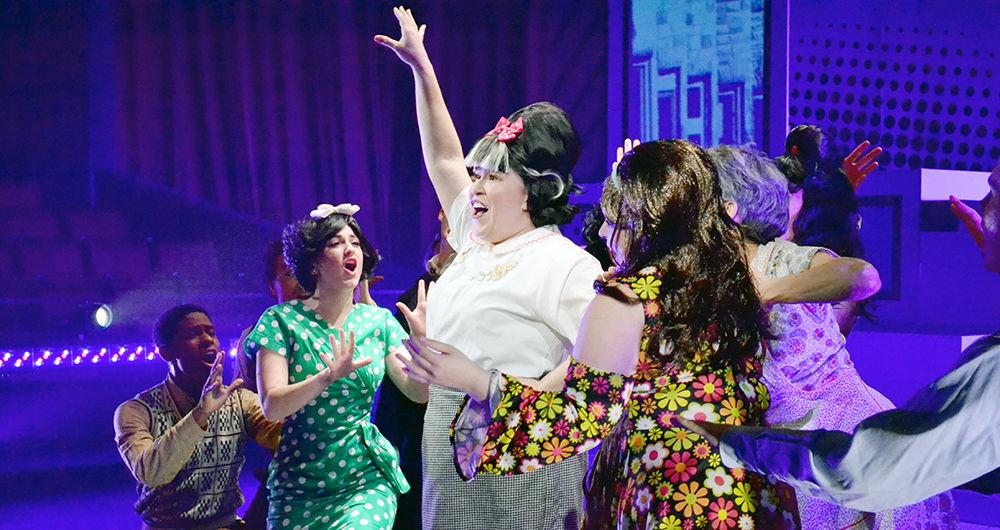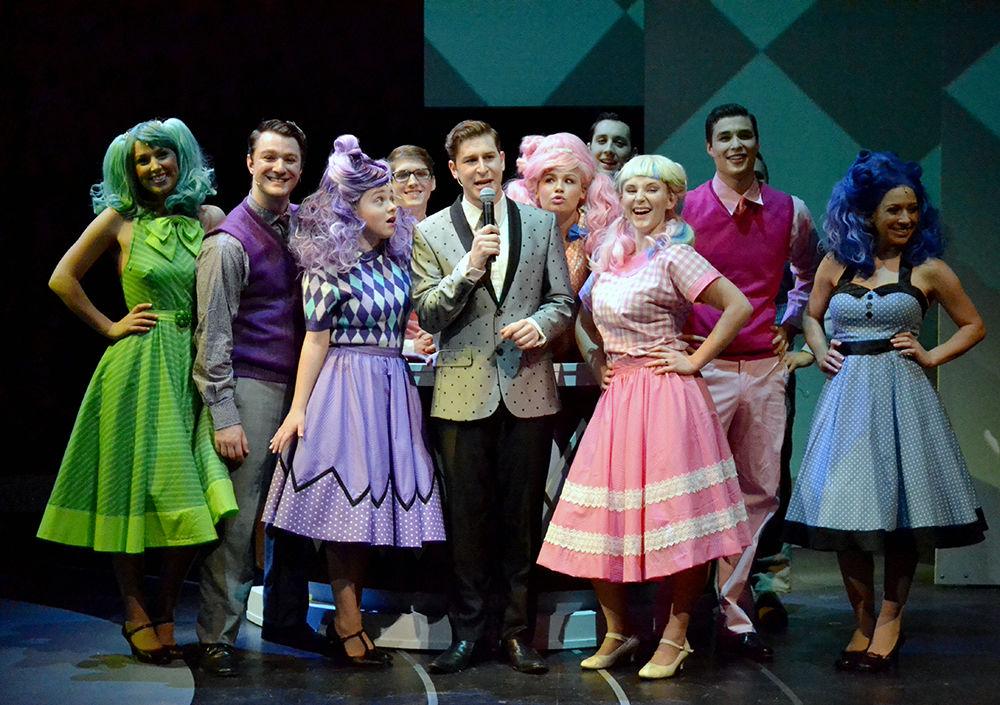Before I even found my seat, the set and lighting crews had already established their mastery of atmosphere, greeting the audience with pink, blue and purple lights that shined through dense clouds of hairspray. The candy-like color palette and vibrant pop images decorating the background provided insight to how a lot of teenagers viewed the ‘60s — energetic, romantic and fun.
University Theatre’s “Hairspray, the Broadway Musical,” directed by John McIlwee, made its debut at 7:30 p.m. on Wednesday, Feb. 21. The production is based off of the original 1988 film, and tells the story of Tracy Turnblad, a slightly plump teenager with dreams of dancing on the Corny Collins Show. The play tackles themes of discrimination and inclusion in more ways than one.
Each cast member functions as their own separate entity. A good amount of musicals tend to have characters that dance in a well-choreographed mob and lack any sort of depth outside of that, however this interpretation promotes its theme of individuality even through the dances.
Tim Fitch, a fifth-year studying mechanical engineering, acted out multiple parts in an ensemble role. Fitch said the actors added real color to their characters and interactions.
“It’s like everyone’s done their homework on developing the characters, saying things like ‘okay, who do my characters like?’” Fitch said. “‘Who do they not like? What characters do I know? What characters do I not know?’ All of those decisions really build something on stage that becomes much more real.”
A backstage orchestra accompanied the production, matching and enhancing the tone of each scene and laying the foundation for every musical number. It also managed its levels very well, never being so overbearing as to drown out the singing and dialogue, but also never allowing itself to be overshadowed by the vocals. The variations in meter were also very pleasing and ensured that no two songs would sound the same.
Parker Gagnier, a third-year studying English, played the role of Fender, one of the lead dancers. Despite having experience singing in five other University Theatre productions, Gagnier said he struggled with the role initially due to it being his first time dancing for a show.
“Some groups didn’t get as much time to go over the choreography as others, but the way the cast has come together to help each other has made it much better,” Gagnier said. “Before we had rehearsals every day except Friday and Saturday, and then we had a nine-to-10-hour rehearsal on Sundays, but now that we’re getting closer to the debut, we’re having rehearsals every day until the show starts. We’re putting in lots of hours; it’s getting to crunch time. This isn’t even counting the hours we practiced outside of rehearsal. This cast is the most dedicated I’ve been in, period.”
Gagnier’s statement reflects well on the quality of the show. University Theatre’s “Hairspray” is an incredibly well-crafted production and every moment the team spent rehearsing is evident in the final product.
The masterful use of lighting and color augments the tone of each scene and makes the tonal shifts in the story much more surprising. A good example of this was at the start of Velma’s first solo, “Miss Baltimore Crabs.” Up to this point, the musical spent a good deal of time establishing the pinks, purples and blues as its color palette. However, once the spotlight is on Velma, the usual lights go out and are replaced with a harsh red, shattering the false sense of security the musical built up and establishing the character’s purely hostile disposition toward the protagonists.
McIlwee took liberties in restructuring the narrative to develop the characters more outside of Tracy. One of the first musical numbers in Act 1 takes the relationship Tracy has with Edna in the beginning and juxtaposes it with what Penny and Amber have with their mothers. Little Inez shows up much earlier in this show than in Adam Shankman’s 2007 film, allowing us to witness more of her dynamics with Seaweed and the white students.
There’s even some backlash toward Tracy from the minority students after the group gets arrested during their protest, which serves as a reminder that change — while something that people can bring about when they work together — doesn’t always come easily/
Unfortunately, University Theatre’s production “Hairspray, the Broadway Musical” sold out quickly after its debut, thus anyone who hasn’t already made plans to see it won’t be able to. This shouldn’t deter anyone from supporting University Theatre, however. Peter Lalush’s “Girl in Space” premieres on March 15, and Mary Chase’s Harvey follows on April 12. “Hairspray” may not be showing anymore after Feb. 25, but that shouldn’t stop University Theatre from putting out more shows of a similar quality.
The cast of the Corny Collins show dance on television to the song, “The Nicest Kids in Town,” during the "Hairspray" musical in Stewart Theatre in Talley Student Union on Tuesday. The musical is about a girl named Tracy, trying to change the world despite other people doubting her abilities.














